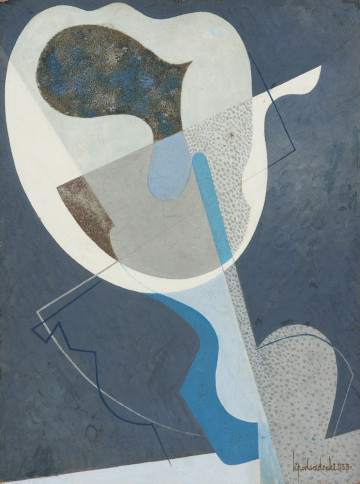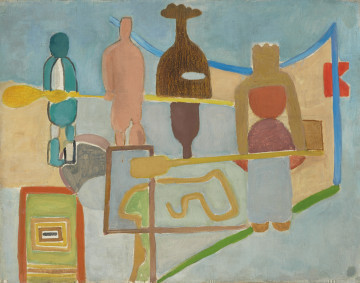
Cannibal Ship
1972
National Museum in Szczecin
Part of the collection: European classics of modernity
Jonasz Stern studied in Lviv under Paweł Gajewski and in Krakow under Teodor Axentowicz, Władysław Jarocki, Stanisław Kamocki and Fryderyk Pautsch. In 1931, he took part in the founding (I) of the Cracow Group, which brought together avant-garde youth who cooperated with the Artes group from Lviv and the a.r. group from Łódź. At that time Stern created painterly compositions on the verge of cubism and abstraction, as well as satirical drawings and graphics with a critical and political undertone. Frequent arrests as a member of the Polish Communist Party, a stay at Bereza Kartuska (1938), later in the Lviv ghetto and the local Janowska Camp (1941), an escape from an execution site (1943), and a wandering through Hungary to Kraków had a fundamental impact on the painter's mature artistic output. However, Stern once again came into contact with the circle of modernists gathered around Tadeusz Kantor (Grupa Młodych Plastyków, Klub Artystów), and apart from visual paradigm documenting the trauma of war, he returned to formal experiments close to organic abstraction and surrealism. He never submitted to the doctrine of socialist realism. In order to avoid the subordination of painting to its principles, he employed himself in the Municipal Retail Trade as a designer of shop windows, and from 1952 he began to conduct a study of occasional decorations at his alma mater, the Academy of Fine Arts in Kraków. In the same year, during a summer canoe trip, he became interested in fishing. When in 1959, in Italy, he came into contact with the textural, tactile paintings of Albert Burri and the theory of the painting of matter (l'arte polimaterica), bones, fish skins and scales became frequent elements included in Stern's painting compositions. For two years, the artist was already the core of the 2nd Kraków Group, in which convex collage or assemblage was used, among others, by Erna Rosenstein and Jadwiga Maziarska. The result were poetic, metaphorical arrangements, sometimes bringing to mind traditional genres of still life or landscape, and in Stern's case never devoid of decorative values, but also highly emotionally charged.
Szymon Piotr Kubiak
Author / creator
Dimensions
cały obiekt: height: 55 cm, width: 80 cm
Object type
painting
Creation time / dating
Creation / finding place
Identification number
Location / status

1972
National Museum in Szczecin

1933
National Museum in Szczecin

1949
National Museum in Szczecin
DISCOVER this TOPIC
Museum of King Jan III's Palace at Wilanów
DISCOVER this PATH
Educational path